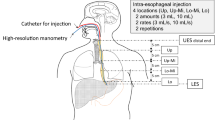Abstract
Pressure changes were registered with videomanometry (simultaneous manometry and barium swallow) in the pharynx and in the pharyngoesophageal segment (PES) during swallowing. A considerable longitudinal asymmetry was found. Peak pressure was highest in the PES, lower in the inferior constrictor area, and lowest at the level of the tongue base. The rate of pressure rise was highest at the level of the PES. The speed of propagation of the contraction wave was 13 (±2) cm/sec. There was no correlation between the measured variables (i.e., peak pressure, rate of pressure rise, and speed of contracting wave). Our findings can partly be explained by different mechanical constraints at different levels of the pharynx but may also reflect the organization of neural control of swallowing in the brainstem. Knowledge of transducer position and orientation is essential for the evaluation of pharyngeal pressure during swallowing. Such knowledge is best achieved by performing manometry simultaneously with fluoroscopy, i.e., videomanometry.
Similar content being viewed by others
References
Ekberg O: Editorial: On timing: “brief encounter.” Dysphagia 8:41–42, 1993
Castell JA, Dalton CB, Castell DO: Pharyngeal and upper esophageal sphincter manometry in humans. Am J Physiol 258:G173-G178, 1990
Kahrilas PJ, Logemann JA, Lin S, Ergun GA: Pharyngeal clearance during swallowing: a combined manometric and video-fluoroscopic study. Gastroenterology 103:128–136, 1992
Sears VW, Castell JA, Castell DO: Radial and longitudinal asymmetry of human pharyngeal pressures during swallowing. Gastroenterology 101:1559–1563, 1991
Castell JA, Castell DO: Modern solid state computerized manometry of the pharyngeoesophageal segment. Dysphagia 8:270–275, 1993
Cook IJ, Dodds WJ, Dantas RO, Kern MK, Massey BT, Shaker R, Hogan WJ: Timing of videofluoroscopic, manometric events, and bolus transit during the oral and pharyngeal phases of swallowing. Dysphagia 4:8–15, 1989
McConnel FMS, Guffin TN, Cerenko D, Shyh-Feng Ko A: The effects of bolus flow on vertical pharyngeal pressure measurement in the pharyngoesophageal segment: clinical significance. Otolaryngol Head Neck Surg 106:169–174, 1992
Wilson JA, Pryde A, Macintyre CCA, Heading RC: Normal pharyngoesophageal motility: a study of 50 healthy subjects. Dig Dis Sci 34:1590–1599, 1989
Kahrilas PJ, Logemann JA: Volume accommodation during swallowing. Dysphagia 8:259–265, 1993
Ekberg O: Radiologic evaluation of swallowing. In Groher ME (ed): Dysphagia: Diagnosis and Management, 2nd ed. Stoneham, MA: Butterworth-Heinemann, pp 163–195
Curtis DJ: Radiologic examination of the esophageal region. In Gelfand DW, Richter JE. Dysphagia: Diagnosis and treatment. New York: Igaku-Skoin, 1989, pp 31–43
Jones B, Donner MW: The tailored examination. In Jones B, Donner MW (eds): Normal and abnormal swallowing. New York: Springer Verlag, 1991, pp 33–50
Miller AJ: The search for the central swallowing pathway: the quest for clarity. Dysphagia 8:185–194, 1993
Jean A: Brainstem organization of the swallowing network. Brain Behav Evol 25:109–116, 1984
Amri M, Car A, Jean A: Medullary control of the pontine swallowing neurons in sheep. Exp Brain Res 55:105–110, 1984
Jean A: Control of the central swallowing program by inputs from the peripheral receptors. A review. J Autonom Nerv Syst 10:225–233, 1984
Dantas RO, Kern NK, Massey BT, Dodds WJ, Kahrilas PJ, Brasseur JG, Cook IJ, Lang IM: Effect of swallowed bolus variables on oral and pharyngeal phases of swallowing. Am J Physiol 258:G675-G681, 1990
Borgström PS, Ekberg O: Peristalsis in pharyngeal constrictor musculature in relation to positioning and gravity. Acta Radiol 30:183–185, 1989
Borgström PS, Ekberg O: Speed of peristalsis in pharyngeal constrictor musculature: correlation to age. Dysphagia 2:140–144, 1988
Li Q, Castell JA, Castell DO: Manometric evaluation of prepharyngeal pressure and pharyngeal clearing contraction in the hypopharynx (Abstract) First Dysphagia Research Meeting, Milwaukee 1992
Olsson R, Nilsson H, Ekberg O: Simultaneous videoradiography and computerized pharyngeal manometry: videomanometry. Acta Radiol 35:30–34, 1994
Ergun GA, Kahrilas PJ, Logemann JA: Interpretation of pharyngeal manometric recordings: limitations and variability. Dis Esophagus 6:11–16, 1993
Brasseur JG, Dodds WJ: Interpretation of intraluminal manometric measurements in terms of swallowing mechanics. Dysphagia 6:100–119, 1991
Author information
Authors and Affiliations
Rights and permissions
About this article
Cite this article
Olsson, R., Kjellin, O. & Ekberg, O. Videomanometric aspects of pharyngeal constrictor activity. Dysphagia 11, 83–86 (1996). https://doi.org/10.1007/BF00417894
Issue Date:
DOI: https://doi.org/10.1007/BF00417894




